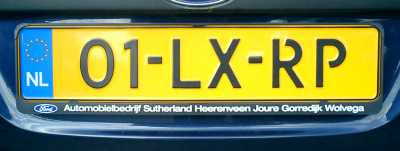
The picture above shows a Dutch car license plate. Notice anything strange about it? Something odd about the letters “R” and “P”? The strokes of the letters are not completely joined up.
I’ve been trying to dig up some information about this typographic oddity, but I haven’t found anything concrete yet. My best guess is that styling these two letters this way makes computerised license plate identification easier. I’m no expert on optical character recognition, but it I’m sure that every little visual cue that distinguishes one character from another, helps in improving accuracy and processing speed. In the case of license plates, they must still remain easily readable by humans, so small adjustments, like the gaps in the letters “R” and “P” are probably a good compromise.
If you’re just taking a “wet film” image, or a digital snapshot of a car and its plates for later processing, then the speed and accuracy of identification of important, but not critical. If the computer system cataloguing the photos has trouble reading a given plate, it can flag an exception, and get a human being to check its work.
However, the Dutch police and Ministry of Transport are experimenting with traffic control systems where speed and accuracy of identification is critical. On the A-2 motorway between Amsterdam and Utrecht, they no longer just measure a car’s speed with a simple radar or laser speed camera. They use a connected network of cameras and detectors to identify cars at multiple places, so that the system is aware of the car’s average speed over that stretch of road.
It’s no longer any good just slowing down if you know a speed camera is up ahead, and then speeding up immediately afterwards. By measuring your average speed, you have to keep your speed down over that stretch of road.
Because you now need two cameras to monitor a stretch of road (one at the start, one at the end), you will be taking twice the number of images, and processing twice the number of license plates. If the accurancy of recognition remains the same as before, then you will also be generating twice as many exceptions, which requires twice as much human input to correct.
Also, because you have to correlate multiple data points, you have to identity the license plate correctly at both the entry and exit point in order to measure the car’s average speed.
Looking at this from the point of view of a motorist, say you have a 90% chance of being accurately identified at each speed camera. If you have to be identified by both cameras, then you have two chances of slipping through that 10% gap. The overall probability of getting caught therefore comes down to just 81%. (Note: 90% is just a number pulled out of thin air to make the point. The real-life identification rate will be different.)
Looking at it from the point of view of the system designers, if you want to maintain a 90% accuracy rate over the two cameras combined, then you have to increase the accuracy of each individual camera to about 95%. So accurancy becomes a hot issue.
Speed of processing also becomes much more important, because you now have to identify the license plate of every car that passes the camera, not just the ones radar tells you are breaking the speed limit. The number of license plates that need to be processed every takes an enormous leap upwards….
…which brings us back to the need for accuracy. Because the more identifications you make, the more error reports will be generated, and the more manpower will be needed to verify them. If the system is not accurate enough, it either becomes a manpower nightmare, or you end up with enough violaters slipping through the net that it’s no more effective than single-point speed cameras.
Does it work? Oh yes. Here are some statistics, from the Dutch Institute for Traffic Care (ITC):
- 99.7% accuracy over the course of 24/7 operation
- Number of speeding violations dropped by 90%, from 6% of traffic to 0.6%
- Average speed on the monitored stretches of road has dropped from 72mph (115km/h) to 66mph (105km/h)
Accident rates have dropped, and congestion has decreased.
The gaps in the letters “R” and “P” on Dutch number plates are therefore just one element in a very interesting and highly advanced transport strategy.
Related Links


